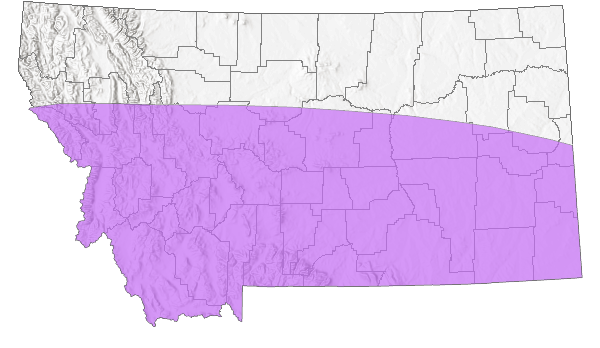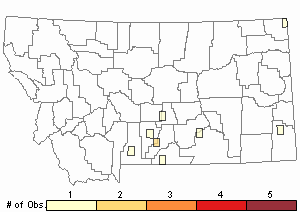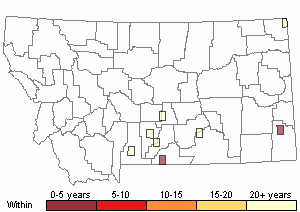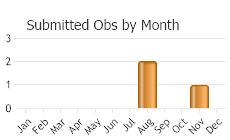View in other NatureServe Network Field Guides
NatureServe
Montana
Utah
Wyoming
Idaho
Wisconsin
British Columbia
South Carolina
Yukon
California
New York
Dark Jerusalem Cricket - Ammopelmatus fuscus
General Description
The following is taken from Hebard (1928), Helfer (1971), Vickery and Kevan (1985), Capinera et al. (2004), and Scott (2010). A large, wingless insect, with a large orangish-yellowish head with eyes and antennae spread widely apart. Abdominal segments are banded with black and whitish stripes. Legs are stout with strong heavy spines for digging. Jerusalem crickets can bite when handled. They are not poisonous but can inflict a bite that results in moderate, short-lived pain. Do not leave Jerusalem crickets in mesh insect nets nor plastic bags. They possess powerful, sharp jaws and easily cut through fabrics and thin plastic.
The Jerusalem Cricket has many other vernacular names such as potato bug, stone cricket, sand cricket, skull cricket, and “child of the earth.” These names have cultural, ethnic, religious, folklore, or food habit origins. Its most commonly used vernacular name, Jerusalem cricket, is misleading because this species is not a cricket. True crickets belong to the family Gryllidae while this species belongs to the family Stenopelmatidae. It is not named after, nor even occurs in Jersalem. The name “Jerusalem” is derived from what had been historically a profane word uttered emphatically and involuntarily when startled. For more details regarding the origins of these names, refer to the papers by Stoffolano and Wright (2005), and Weissman (2005).
Phenology
Little has been recorded relative the Jerusalem cricket’s seasonal and monthly occurrence. It spends most of its life cycle underground and is seldom observed. The most likely time of year to encounter a Jerusalem cricket during the daytime is in the spring when they come to the surface to mate. However, this species has been found active in houses year around, even in winter (Anon 2014, and Mitton 2017).
Diagnostic Characteristics
The following comes from Hebard (1928), Helfer (1971), Vickery and Kevan (1985), Capinera et al. (2004), and Scott (2010). Adult body size for both males and females is 35 mm to 50 mm. The front leg tibia has three narrow spines in a near-linear row on the ventral surface, five broad spines at or near the tip, and the hind leg tibia possesses two side-by-side spines on the ventral surface near the tip. The tarsal foot segments have bottom pads underneath.
This species is distinctive in body form and color pattern, and is easily identified. Taxonomically, however, entomologists speculate that at least 60 species of Jerusalem crickets occur in the U.S. but only 14 have so far been described. It is also possible that the species described here may not be a single species but among a complex of species (Capinera et al. 2004).
Species Range
Montana Range
Range Descriptions

 Native
Native
Range Comments
This species is widely distributed west of the Central Plains to the Pacific coast, southward from British Columbia, Washington, Idaho and Montana to the Mexican border. In Montana, it has been reported for 11 counties (Hebard 1928, Helfer 1971, Vickery and Kevan 1985, Capinera et al. 2004, and Scott 2010).
Observations in Montana Natural Heritage Program Database
Number of Observations: 12
(Click on the following maps and charts to see full sized version)
Map Help and Descriptions
Relative Density

Recency


 (Observations spanning multiple months or years are excluded from time charts)
(Observations spanning multiple months or years are excluded from time charts)
Habitat
The Jerusalem Cricket is subterranean, nocturnal, and occurs in a wide variety of habitats, including homes. It can be found under rocks, logs, and debris and prefers sandy soils (Vickery and Kevan 1985, Capinera et al. 2004, and Mitton 2017).
Food Habits
In the daytime it feeds underground consuming roots, tubers, and decaying plant material. During the night, especially after rain, they come to the surface to feed on live insects, animal material, and plant debris. Underground they can become garden and crop pests feeding on tubers like carrots and potatoes, hence their common name “potato bug” (Vickery and Kevan 1985, Capinera et al. 2004, and Mitton 2017).
Reproductive Characteristics
Jerusalem crickets have a low rate of reproduction, requiring 2 to 5 years (depending on geographical latitude) to reach maturity, and live in the adult stage for 2 to 6 months. The 3 mm, white oval eggs resemble a bird’s nest or saucer, and are laid in small masses. During courtship, both males and females produce a drumming vibration by striking their abdomens on the substrate to attract the attention of a potential mate. In some species of Stenopelmatus, the drumming is audible to humans up to about 60 feet away as the sound travels through the soil. Since Jerusalem crickets lack a tympanum (auditory membrane), they possess subgenual organs (sound receptors located at the tip of the tibia) located on each leg to sense the vibrations from the substrate. When a pair meets, the male initiates mating by pouncing on the female or rolling on his side. He usually bites her hind tibia, places his hind leg tarsi on her third coxae (a short segment between the leg and body) and curls his abdomen between his and her hind legs toward her genital area. He shifts his two incurved genital hooks on his abdominal tip searching for the correct location to anchor them under the posterior edge of the female’s 6th abdominal sternite (segment). Once attached, the male everts his phallic lobes and, upon genital coupling, passes a spermatophore (a packet containing the sperm). However, studies have shown that males that are smaller than (or the same size) the female’s body length are more successful at copulation. The probability of successful copulation declines 50% for males larger than 0.25 inches and decreases more as his size exceeds hers. The mating act is like a “rough and tumble wrestling match.” After successful mating, the female often kills and consumes the male (Mitton 2017, and Weissman et al. 2008).
Stewardship Responsibility
References
- Literature Cited AboveLegend:
 View Online Publication
View Online Publication Anon. 2014. Jerusalem cricket. Colorado State University Extension Service, TriRiver Area.
Anon. 2014. Jerusalem cricket. Colorado State University Extension Service, TriRiver Area. Capinera, J.L., R.D. Scott, and T.J. Walker. 2004. Field Guide to Grasshoppers, Katydids, and Crickets of the United States. Ithaca, NY. Cornell University Press.
Capinera, J.L., R.D. Scott, and T.J. Walker. 2004. Field Guide to Grasshoppers, Katydids, and Crickets of the United States. Ithaca, NY. Cornell University Press. Hebard, M. 1928. The Orthoptera of Montana. Proceedings of the Academy of Natural Sciences of Philadelphia, Vol. 80:211-306.
Hebard, M. 1928. The Orthoptera of Montana. Proceedings of the Academy of Natural Sciences of Philadelphia, Vol. 80:211-306. Helfer, J.R. 1971. How to Know the Grasshoppers, Crickets, Cockroaches, and Their Allies. Revised edition (out of print), Mineola, NY: Dover Publications.
Helfer, J.R. 1971. How to Know the Grasshoppers, Crickets, Cockroaches, and Their Allies. Revised edition (out of print), Mineola, NY: Dover Publications. Mitton, J. 2017. A startling creature in the sand. Colorado Arts and Sciences Magazine. Boulder, CO: University of Colorado. Accessed 8 December 2020. https://www.colorado.edu/asmagazine/2017/05/05/startling-creature-sand
Mitton, J. 2017. A startling creature in the sand. Colorado Arts and Sciences Magazine. Boulder, CO: University of Colorado. Accessed 8 December 2020. https://www.colorado.edu/asmagazine/2017/05/05/startling-creature-sand Scott, R.D. 2010. Montana Grasshoppers, Katydids, and Crickets A Pictorial Field Guide to the Orthoptera. MagpieMTGraphics, Billings, MT.
Scott, R.D. 2010. Montana Grasshoppers, Katydids, and Crickets A Pictorial Field Guide to the Orthoptera. MagpieMTGraphics, Billings, MT. Stoffolano, J.B. and B. Wright. 2005. Sósòöpa—Jerusalem Cricket: An important insect in the Hopi Katsina Pantheon. American Entomologist 51(3):174-179.
Stoffolano, J.B. and B. Wright. 2005. Sósòöpa—Jerusalem Cricket: An important insect in the Hopi Katsina Pantheon. American Entomologist 51(3):174-179. Vickery, V. R. and D. K. M. Kevan. 1985. The grasshopper, crickets, and related insects of Canada and adjacent regions. Biosystematics Research Institute, Ottawa, Ontario. Publication Number 1777. 918 pp.
Vickery, V. R. and D. K. M. Kevan. 1985. The grasshopper, crickets, and related insects of Canada and adjacent regions. Biosystematics Research Institute, Ottawa, Ontario. Publication Number 1777. 918 pp. Weissman, D.B. 2005. Jerusalem! Cricket? (Orthoptera: Stenopelmatidae: Stenopelmatus); Origins of a Common Name. American Entomologist 51(3):138-139.
Weissman, D.B. 2005. Jerusalem! Cricket? (Orthoptera: Stenopelmatidae: Stenopelmatus); Origins of a Common Name. American Entomologist 51(3):138-139. Weissman, D.B., K.A. Judge, S.C. Williams, D.W. Whitman, and V.F. Lee. 2008. Small-male mating advantage in a species of Jerusalem cricket (Orthopter: Stenopelmatinae: Stenopelmatus). Journal of Orthoptera Research 17(2):321-332.
Weissman, D.B., K.A. Judge, S.C. Williams, D.W. Whitman, and V.F. Lee. 2008. Small-male mating advantage in a species of Jerusalem cricket (Orthopter: Stenopelmatinae: Stenopelmatus). Journal of Orthoptera Research 17(2):321-332.
- Additional ReferencesLegend:
 View Online Publication
View Online Publication
Do you know of a citation we're missing? Hebard, M. 1932. Notes on Montana Orthoptera. Proceedings of the Academy of Natural Sciences of Philadelphia. V. 84. pp 251-257.
Hebard, M. 1932. Notes on Montana Orthoptera. Proceedings of the Academy of Natural Sciences of Philadelphia. V. 84. pp 251-257. Wilcox, J.T. 2018. Jerusalem cricket (Stenopelmatus spp.) Jerusalem! I see linkages: The community value of a misunderstood insect. Davis, CA: California Native Grasslands Association. Grasslands Summer 2018:6-8.
Wilcox, J.T. 2018. Jerusalem cricket (Stenopelmatus spp.) Jerusalem! I see linkages: The community value of a misunderstood insect. Davis, CA: California Native Grasslands Association. Grasslands Summer 2018:6-8.
- Web Search Engines for Articles on "Dark Jerusalem Cricket"
- Additional Sources of Information Related to "Insects"





